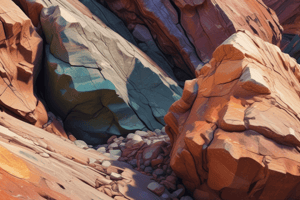Podcast
Questions and Answers
What is the primary factor that contributes to the formation of metamorphic rocks?
What is the primary factor that contributes to the formation of metamorphic rocks?
- Volcanic activity
- Pressure and temperature (correct)
- Sedimentation
- Chemical weathering
Which of the following changes is primarily associated with the metamorphic process?
Which of the following changes is primarily associated with the metamorphic process?
- Color changes
- Chemical composition changes
- Textural changes (correct)
- Biological changes
What is foliation in metamorphic rocks primarily caused by?
What is foliation in metamorphic rocks primarily caused by?
- Uniform stress application
- Cooling of lava
- Differential stress (correct)
- Chemical reactions
What type of metamorphism involves high pressure and temperature over large areas?
What type of metamorphism involves high pressure and temperature over large areas?
Which metamorphic rock transformation involves the addition and subtraction of elements?
Which metamorphic rock transformation involves the addition and subtraction of elements?
What is a characteristic feature of migmatites?
What is a characteristic feature of migmatites?
Which type of metamorphism is prevalent at the contact point between magma and surrounding rock?
Which type of metamorphism is prevalent at the contact point between magma and surrounding rock?
Which of the following is NOT a characteristic of the metamorphic process?
Which of the following is NOT a characteristic of the metamorphic process?
Flashcards are hidden until you start studying
Study Notes
Metamorphic Rock Formation
- Metamorphic rocks form when existing rocks change under pressure, temperature, and subterranean fluids.
- Rocks remain solid during metamorphism.
- Changes affect texture, mineralogy, or both.
Metamorphic Rock Changes
- Changes in pressure and temperature have minimal compositional changes, mostly textural.
- Volatiles like water and carbon dioxide are lost.
- Changes due to fluids include addition or removal of elements, or both (metasomatism).
Metamorphic Limits
- Changes occur while rocks remain solid.
- Migmatites have partial melting resulting in segregation of the initial material.
- Leucosome (acidic composition) and Melanosome (basic composition) are formed.
Temperature-Driven Metamorphism
- The transformation from limestone to marble involves rock recrystallization.
Pressure-Driven Metamorphism
- Mostly caused by tectonic stress.
- Differential stress aligns minerals perpendicular to the direction of stress.
- This forms foliation or layering in metamorphic rocks.
Foliation in Metamorphic Rocks
- Folded gneiss with significant pressure and relatively low temperatures.
- Folded schist with significant pressure and relatively low temperatures.
Types of Metamorphism
- Three main types: Regional, Contact, and Burial.
Regional Metamorphism
- Barrovian type.
Contact Metamorphism
- Buchan type.
Burial Metamorphism
- Occurs with increasing depth and pressure.
Studying That Suits You
Use AI to generate personalized quizzes and flashcards to suit your learning preferences.




